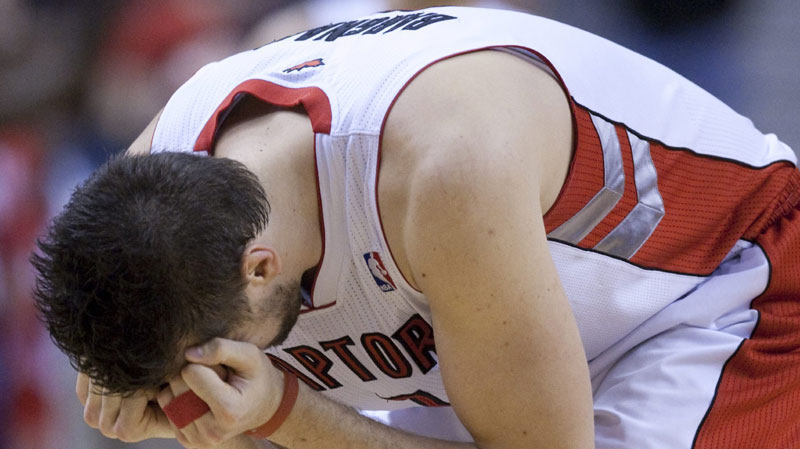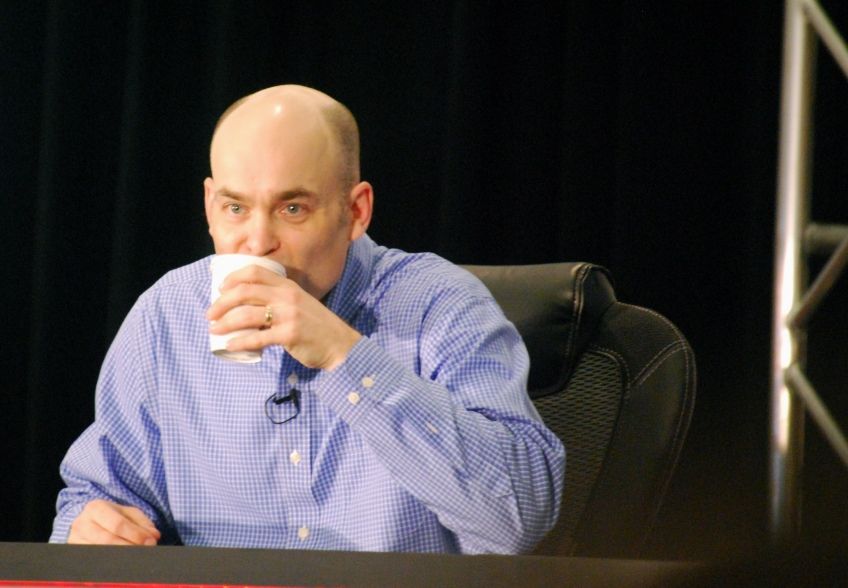As promised, now that ESPN’s John Hollinger has released his player evaluations for the Toronto Raptors, I’m ready to share my take on his take.
On Hollinger
I know Hollinger gets a bad rap for a few things and there are vocal groups who don’t like him, but I find his written player profiles to be of value. For one, he sees a lot more data and video and basketball than I do, so I trust that he generally knows what he’s talking about (even if his once cutting-edge stats are now usurped by those of Basketball Reference, 82Games and more). In addition, when it comes to non-Raptors, it’s a handy first checkpoint for scouting, because his profiles do a good job wrapping up the players into simple generalities. (This obviously isn’t a healthy habit as a standard operating procedure, but for a first-glance it’s valuable).
Pay-Wall Caveat
With that long-winded introduction done, allow me one more unnecessarily wordy caveat – his player profiles are behind the ESPN Insider pay wall. As an ESPN Insider, I get access to the Hollinger stats and player profiles, while non-members, I believe, only get snippets. So in my reactions below, I kind of have to toe the line with respect to giving away too much of the “pay” content. Hopefully I’ve found a happy mid-way point between giving away his content and not providing anything of value.
Method
I looked at Hollinger’s three “Scouting Report” bullets, wrote my reaction, and then read his “Analysis” portion to see if I missed any salient points.
Today we’ll start with part one and examine the guards and wings, while tomorrow we’ll take a look at the big men.
Projected Starters – Kyle Lowry, DeMar DeRozan, Landry Fields, Andrea Bargnani, Jonas Valanciunas
Point Guards
Kyle Lowry
Hollinger Pro: Aggression, toughness, ball pressure, defense; improved outside shooting; excellent rebounder; draws fouls
Hollinger Con: Short; can get out of control
My Take: Seems pretty glowing and relatively accurate from my end. While they note that Lowry’s defensive metrics slacked last year, that is partly attributable to his unhappiness with his situation (not that it’s a valid excuse for a professional basketball player). I’ve loved what I’ve heard about him so far from camp – I love hearing the “refuses to lose in practice” line about players I’m going to have to watch and care about for 82 games.
Jose Calderon
Hollinger Pro: Takes care of ball, finds open man; outside shooting
Hollinger Con: Abused by fast guards; doesn’t get into paint; injury-prone
My Take: Calderon lead the league in Pure Point Rating last year, but the negatives in his profile, mainly his defense, hold him back. I’d say, at the very least, his defensive effort and intelligence improved last year, but his foot speed isn’t going to improve at 31. He’s in that awkward position of being a below-average starter but probably too good to be a low-minute reserve. Unmentioned is his leadership ability, which will hopefully stay in tact in a reserve role.
John Lucas
Hollinger Pro: Quick, outside shot, scorer
Hollinger Con: Doesn’t draw fouls; lacks vision; too small
My Take: I did not realize his two-point shooting was about equal with his three-point shooting, and I was surprised just how extreme his lack of free throws was. With that said, he still seems capable as a Microwave Man off the bench, and you can do much worse for a third point guard. Defensively, I agree with Hollinger that the jury is out until he has some minutes with non All-Defense caliber big-men.
Wings
Demar DeRozan
Hollinger Pro: Gets to rim, draws fouls, good from midrange; finishing ability; some defensive tools
Hollinger Con: One-dimensional; ball hog, poor handle; lacks defensive focus
My Take: Well, if that last ‘con’ point is correct, DeRozan will be in tough for minutes in Casey’s wing-heavy, accountability-driven rotation. I wouldn’t say that DeMar is one-dimensional, moreso that he’s been used in a single dimension so far. Hopefully with a different style of point guard and other floor spacers, he can work off the ball more to leverage his mid-range talents (note: not long-two talents). DeRozan’s biggest potential for offensive improvement is adding a three-ball to his repertoire, which Hollinger doesn’t point out but I feel is a key to his taking the next step.
Landry Fields
Hollinger Pro: Rebounding, quick leaper; smart player, good off-ball; never fouls
Hollinger Con:Poor shooter; rarely attacks
My Take: Well if “poor shooter, rarely attacks” is a player’s actual profile, where does he belong in an NBA starting lineup? I understand there are points on the spectrum between there, and Hollinger himself notes how he gets himself easy buckets and contributes in a lot of smaller ways, but there’s no question in my mind that Fields’ shooting has to improve for him to provide adequate value. I believe the Raptors think they’re getting somewhere closer to his rookie year shooting profile, and the intangibles and Casey-ness of his profile are obvious (late addition: Battier-comparison from Casey today, according to Twitter).
Linas Kleiza
Hollinger Pro: Physical; strong drive to rim
Hollinger Con: Fouls a lot; never goes left or passes
My Take: I listed Linas with the wings because the big rotation looks pretty full, so Kleiza will probably have to carve out minutes at the three. Of course, he’s effective as a small-ball four, and the Raptors have the guards to play a small lineup, so maybe he’ll get play that way at the expense of some of the bigs. The book on Kleiza is well established at this point – he’s a versatile scorer but comes with some baggage, specifically in the form of turnovers. His value is probably at it’s highest on the second unit of a team with a poor offensive set of reserves, which this team may or may not be, but it doesn’t seem that way right now. I originally thought he was protected as a Jonas liaison for the year, but the team may opt to deal him to avoid his $4.5M player option for next season.
Terrence Ross
Hollinger Pro: Range; excellent defensive potential
Hollinger Con: Not strong; never draws fouls
My Take: It’s a bit early to write the book on any college player, especially one many of us on the East Coast didn’t get to see much, but this more or less matches what we’ve been hearing all offseason. He doesn’t necessarily need to get to the line on this team, but long-term it’s something he’ll be required to add to his game. Obviously the team, specifically Casey, loves his defensive potential, but his three-point shooting could come in handy to complement the Jose-Jonas pick-and-roll on the second unit.
Alan Anderson
Hollinger Pro: Set shooting; solid defense
Hollinger Con: Overaggressive, sloppy handle; poor rebounder and passer
My Take: I never really caught Anderson’s defensive value last year, perhaps because my brain was too strung out from the season by the time Anderson was carving out minutes. I did, however, notice all the turnovers, and appreciated the three-point shooting. I don’t think we’ll see too much of Double-A this year, so I’m not going to think too much about his profile based on limited exposure.
Dominic McGuire
Hollinger Pro: No profile
Hollinger Con: No profile
My Take: Hollinger doesn’t have a profile done for DMC, but allow me – he’s a strong defender at multiple positions, he has strong rebounding and passing numbers for a wing but his usage rate is insanely low, limiting his PER. He’s also a decent career free throw shooter but has struggled from the field. He should see run at multiple positions, perhaps as a message to other wing players when their defense slips up.
Check back tomorrow for my take on his analysis of our big men. And as always, follow me on Twitter.



